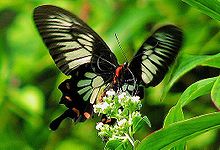Butterflies of Sri Lanka

General description
| Part of a series on |
| Wildlife of Sri Lanka |
|---|
 |
The majority of species are found in the foothills (up to 3,000 feet (910 m) elevation). A much smaller number of species are found above 4,000 feet (1,200 m), while 20 species of butterfly are restricted to the low lying dry zone (below 500 feet (150 m) elevation). The number of butterflies peaks in two seasons during the year. The first of these is during the southwestern monsoon in the months of March to April. The second is during the northeastern monsoon which continues from September to October.
| Feature | Butterflies | Moths |
|---|---|---|
| Shape and structure of antennae | thin slender filamentous antennae which are club-shaped at the end | comb-like or feathery antennae, or filamentous and unclubbed |
| Wing-coupling mechanisms | lack a frenulum | have a frenulum which is a filament arising from the hindwing and coupling (matching up) with barbs on the forewing. The frenulum can be observed only when a specimen is in hand. Some moths have a lobe on the forewing called a jugum that helps in coupling with the hindwing. |
| Pupae | form an exposed pupa, also termed a chrysalis | moth caterpillars spin a cocoon made of silk within which they metamorphose into the pupal stage. |
| Colouration of the wings | bright colours on their wings | usually plain brown, grey, white or black and often with obscuring patterns of zigzags or swirls |
| Activity | diurnal | nocturnal and crepuscular |
| Structure of the body | have slender and smoother abdomens | have stout and hairy or furry-looking bodies |
| Scales | possess fine scales | larger scales on their wings which makes them look more dense and fluffy |
| Appearance of eyes | apposition eyes | superposition eyes |
| Resting posture | fold their wings above their backs when they are perched | rest with their wings spread out to their sides |
Within Sri Lanka, the latest revision of lepidopterans described 1903 species with 58 families of butterflies and moths. Out of these 1903 species, 208 species are butterflies and 1695 species are moths.
The family-wise number of butterfly species are:[2]: 53
| Family | Species |
|---|---|
Papilionidae
|
15 |
Pieridae
|
27 |
| Nymphalidae | 69 |
| Lycaenidae | 86 |
| Hesperiidae | 46 |
| Riodinidae | 1 |
History of studies on butterflies
The first studies of Ceylon butterflies were published by
New species
In 2008, Dr. Michael van der Poorten discovered a new species of Sri Lankan butterfly, the first such discovery in 60 years.[3] The species has been identified as Catopsilia scylla.
Conservation
Endemic species

A majority of endemic species are restricted to the wet zone forests.[2] The Ceylon birdwing is one of the largest endemics of the country and is found in large numbers in the Sinharaja Forest Reserve.[4]
| Common name | Binomial name |
|---|---|
| Ceylon tree-nymph | Idea iasonia
|
| Ceylon tiger | Parantica taprobana
|
| Ceylon palmfly | Elymnias singhala |
| Ceylon treebrown | Lethe daretis |
| Ceylon forester | Lethe dynsate |
| Cingalese bushbrown | Mycalesis rama |
| Sinhalese five-ring | Ypthima singala |
| Blue oak leaf | Kallima philarchus |
| Ormiston's oakblue | Arhopala ormistoni |
| Ceylon cerulean | Jamides coruscans |
| Milky cerulean | Jamides lacteata |
| Woodhouse's four lineblue | Nacaduba ollyetti |
| Pale Ceylon six lineblue | Nacaduba sinhala |
| Green's silverline | Cigaritis greeni |
| Clouded silverline | Cigaritis nubilus |
| Ceylon indigo royal | Tajuria arida |
| Ceylon hedge blue | Udara lanka |
| Lesser albatross | Appias galene |
| One spot grass yellow | Eurema andersonii |
| Ceylon rose | Pachliopta jophon |
| Common birdwing | Troides darsius |
| Black flat | Celaenorrhinus spilothyrus |
| Decorated ace | Halpe decorata
|
source: srilankaninsects.net[1]
See also
References
- ^ a b "Butterflies of Sri Lanka". srilankaninsects.net. Archived from the original on 2009-11-26. Retrieved 2009-11-07.
- ^ ISBN 955-8177-51-2. Retrieved 2009-11-07.)
{{cite book}}: CS1 maint: multiple names: authors list (link - ^ Hopman, Tahnee (February 24, 2008). "Lanka gets new butterfly". The Sunday Times. Retrieved 2009-11-07.
- ^ "Nature's jewels at Sinharaja". Sunday Observer. November 27, 2005. Archived from the original on 2011-06-06. Retrieved 2009-11-07.
- Channa N. B. & Bambaradeniya E. (2006). The Fauna of Sri Lanka: Status of Taxonomy, Research, and Conservation. Colombo, The World Conservation Union (IUCN).
- D'Abrera, B. L. (1998). The Butterflies of Ceylon. Hill House: Melbourne; London. ISBN 0-947352-35-X
- Henry, G. M. R. & Woodhouse, L. G. O. (1942). The Butterfly Fauna of Ceylon. Colombo; Ceylon.
- Moore, F. C. (1880–1887). The Lepidoptera of Ceylon. L. Reeve & Co.: London. 3 v.
- Ormiston, W. (1924). The Butterflies of Ceylon. Colombo, H. W. Cave.
- Pethiyagoda, R. (1998). "The family de Alwis Seneviratne of Sri Lanka: pioneers in biological illustration". Journal of South Asian Natural History. 4: 99–110.
